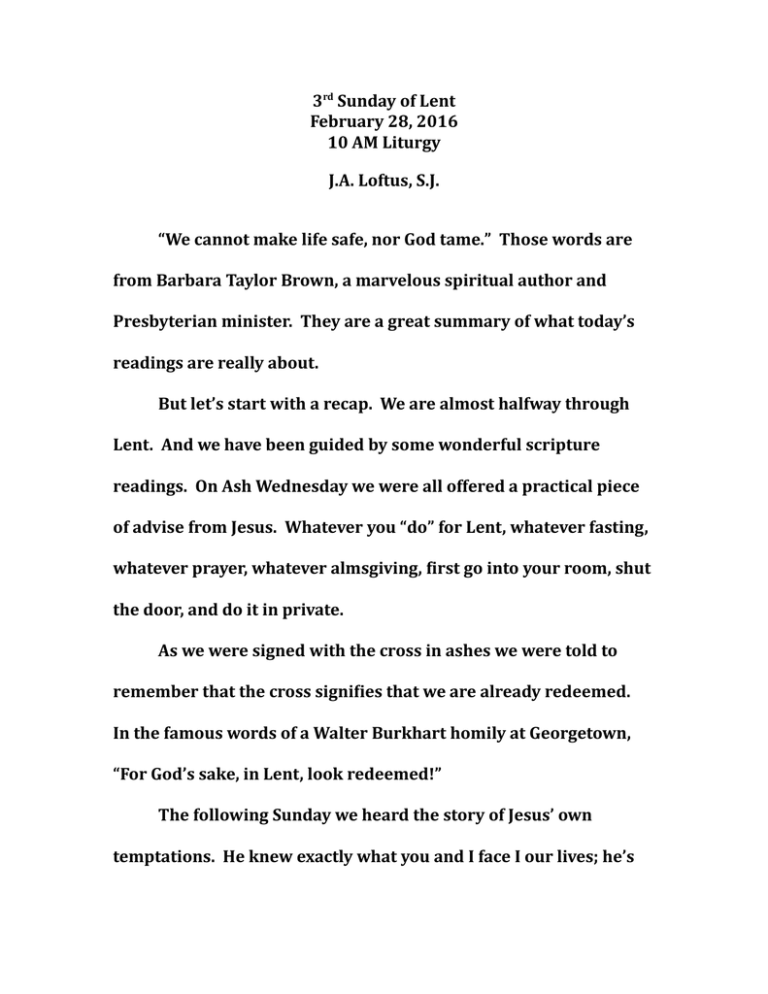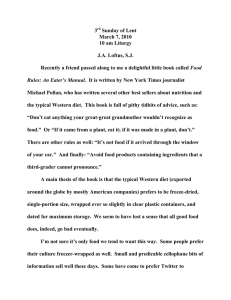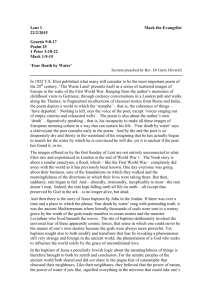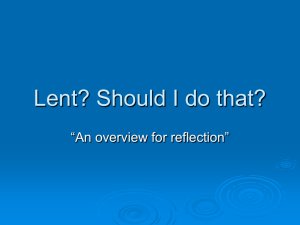3 Sunday of Lent February 28, 2016 10 AM Liturgy
advertisement

3rd Sunday of Lent February 28, 2016 10 AM Liturgy J.A. Loftus, S.J. “We cannot make life safe, nor God tame.” Those words are from Barbara Taylor Brown, a marvelous spiritual author and Presbyterian minister. They are a great summary of what today’s readings are really about. But let’s start with a recap. We are almost halfway through Lent. And we have been guided by some wonderful scripture readings. On Ash Wednesday we were all offered a practical piece of advise from Jesus. Whatever you “do” for Lent, whatever fasting, whatever prayer, whatever almsgiving, first go into your room, shut the door, and do it in private. As we were signed with the cross in ashes we were told to remember that the cross signifies that we are already redeemed. In the famous words of a Walter Burkhart homily at Georgetown, “For God’s sake, in Lent, look redeemed!” The following Sunday we heard the story of Jesus’ own temptations. He knew exactly what you and I face I our lives; he’s been there before us. We also heard from Moses and the memory of Abraham and God’s first Promise to Israel. Last week in addition to Moses again, we saw what awaited Jesus as he morphed on the mountain. It awaits all of us in some fashion too. But we only rarely experience bits and pieces of what it might feel like here in this life. Great readings all to get us started in another Lent. But then we have today’s readings. We have one of the most familiar and evocative scripture passages in the whole bible, Moses and the burning bush. And then we have one of the most ambiguous and enigmatic passages in the New Testament. Are they supposed to “go together” somehow? Are there lessons here for us to take home this Lent? Let’s see. Exodus first: Moses is wandering round Mount Horeb with the in-law’s flock when he is distracted by a burning bush. He decides to take time out and take a look, to digress, to investigate. Do you suppose there might be a lesson right there? Maybe you have to be curious about strange happenings to find God sometimes. We all may have to stop what we’re doing and take a look at strange stuff sometimes. 2 But then God speaks. God reminds Moses that God is holy. And so is God’s ground. “Take off your shoes; this is holy ground you walk on!” This scene is very popular with artists. It has been painted a gazillion times and even sung about in many versions. One version you may recognize written by our own pastor and his assistant (Fr. Bob and Paul Melley). “Take off your shoes, this is holy ground you walk on!” But then Moses asks God, “Who shall I say sent me?” And God offers one of the most enigmatic lines in human history. God says, “Tell them I AM sent you.” There may be some here who think they know what that means. Don’t be so sure. There are various translations attempted over the centuries. Some versions have “I will be who I will be.” Others suggest the simple, “I AM, who I AM.” Not terribly helpful to me, I’m afraid. A lengthier translation is, “I AM who brings all that exists into existence.” Lots of choices. The simple reality is that none of the scholars of the scriptures nor even the philologists have a clue. It remains a deeply mysterious response. Sr. Dianne Bergant says of this passage, ‘this is a God who reveals and conceals at the same time.” 3 One last attempt at translation suggests, God says,“Tell them Mystery has spoken.” I wonder if that might be the closest to reality? To move on: it is often said that the Old Testament is confusing. But Jesus usually clears things up in his story. But not today, friends. St. Luke’s story is at least as confusing as Exodus. Jesus seems almost angry at the disciples who want him to explain a great political sacrilege (Pilate mixing the blood of the rebels with sacrificial blood). Instead of explaining it as having any religious significance at all (no sin here), Jesus condemns them, the questioners. Go figure! And then they move to the construction accident (the fallen tower at Siloam) and want a religious explanation for natural disasters (who sinned here?). They get a double condemnation. To make matters even more confusing, Jesus returns to one of his favorite illustrations, the infamous fig tree. I don’t know about you, but this is all very confusing to me. And at least I know I am not alone. One thing I found consoling was that it almost seems like Jesus just lost his train of thought here. He seems in a different 4 world. I like considering that possibility because, God knows, I can relate to that as I get older. But just maybe there is a serious “take-home” for Lent here. God’s name is impenetrable; God’s son is illusive and sometimes confusing. That can actually be consoling. Remember that in Karl Rahner’s words, what we are always dealing with, God’s real name, is Ultimate Mystery. As Terrence Klein puts it is this weeks America, “The problem with God—and even God’s friends will admit this—is God’s illusiveness. Just when you think you’ve had a solid experience of God…God disappears.” Barbara Taylor Brown’s comment may be more profound that it first seems. “We cannot make life safe, nor God tame.” We stand here today, at this altar, with Ultimate Mystery, with the God of all that has been (The God of Abraham, Isaac and Jacob); we stand before the God of all that is (here and now, today); and we stand before the God of all that shall yet become (our fondest and best dreams). This Lent, maybe we should just take off our shoes and look around. This IS holy ground we walk on. And Lent continues. 5






